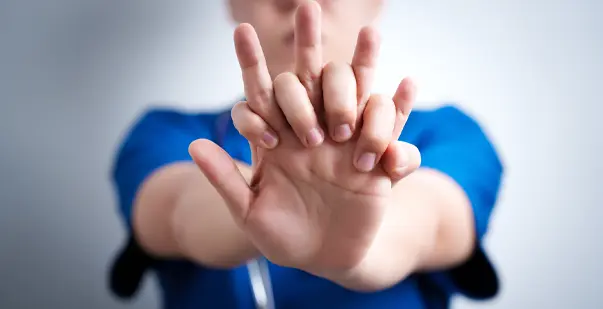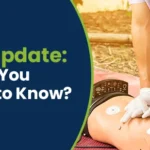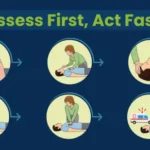Table Of Content(s)
- Introduction
- How to do cardiopulmonary resuscitation: Important Steps and Techniques
- Why CPR Matters: The Importance of Immediate Action
- Step-by-Step Guide to CPR: Adult and Child Techniques
- Common CPR Mistakes and How to Avoid Them
- When to stop CPR?
- Conclusion
Imagine witnessing someone suddenly collapse, their life hanging in the balance. In such critical moments, knowing how to do CPR (cardiopulmonary resuscitation) can make all the difference. CPR is a skill that can double and triple a person’s chance of survival. 90% of people who suffer out of hospital cardiac arrests die. This is because of bystanders failing to offer help due to the lack of awareness. This statistics highlights the importance of staying prepared.
Mastering the skills of cardiopulmonary resuscitation(CPR) isn’t just for healthcare professionals. It is a skill that anyone can learn and should learn. Following a few simple steps, you can act confidently in emergencies. In this blog, you will learn the ways to perform CPR effectively.
Master ACLS Now
Get ACLS certified with confidence
How to do cardiopulmonary resuscitation: Important Steps and Techniques
Cardiac emergencies can happen anytime, anywhere. Knowing how to respond can mean the difference between life and death. Cardiopulmonary resuscitation (CPR) is a critical skill that anyone can learn to provide immediate assistance during a cardiac arrest. Below are the key steps and techniques:
- Ensure the environment is safe, check if the person is responsive, and call for emergency help.
- Tilt the head back and lift the chin to open the airway.
- Look, listen, and feel for breathing for no more than 10 seconds.
- Place your hands in the center of the chest and push hard and fast, at a rate of 100-120 compressions per minute.
- If trained, give two breaths after every 30 compressions, ensuring the chest rises.
- Repeat cycles of 30 compressions and 2 breaths until professional help arrives or the person shows signs of life.
Read More: How to Get a Replacement CPR Card?
Why CPR Matters: The Importance of Immediate Action
Cardiac arrest can occur suddenly, with little to no warning. This leaves individuals in a critical condition where every second counts. Cardiopulmonary resuscitation significantly impacts the outcome of such emergencies.
- Immediate Impact: CPR helps maintain blood flow to the brain and heart, keeping vital organs alive until professional help arrives.
- Survival Chances: Performing CPR within the first few minutes of cardiac arrest can double or triple a person’s chances of survival.
- Critical Timing: For every minute that passes without CPR, the likelihood of survival decreases by about 7-10%.
- Empowerment Through Knowledge: Knowing how to perform CPR can reduce hesitation and fear, allowing you to act confidently in an emergency.
- Chain of Survival: Effective CPR is a key link in the chain of survival. This makes it essential for bystanders to be trained and prepared.
Step-by-Step Guide to CPR: Adult and Child Techniques
Knowing how to perform CPR can be a life-saving skill in emergencies. While the basic principles of CPR remain consistent, the techniques vary slightly depending on the age and size of the person needing assistance. Get a clear, step-by-step approach to performing CPR for both adults and children.
For Adults:
- Begin Chest Compressions: Place your hands in the center of the chest, push hard and fast (at a rate of 100-120 compressions per minute), and allow the chest to fully recoil between compressions.
- Provide Rescue Breaths: If trained, give two breaths after every 30 compressions, ensuring the chest rises with each breath.
For Children (1 year to puberty):
- Open the Airway: Tilt the head slightly backward to open the airway.
- Check for Breathing: Look, listen, and feel for breathing for no more than 10 seconds.
- Begin Chest Compressions: Use one or two hands (depending on the size of the child), push down about 1/3 the depth of the chest at a rate of 100-120 compressions per minute.
- Provide Rescue Breaths: Give two breaths after every 30 compressions, making sure to cover the child’s mouth and nose with your mouth.
For Infants (under 1 year):
- Open the Airway: Gently tilt the head back to open the airway.
- Check for Breathing: Look, listen, and feel for breathing for no more than 10 seconds.
- Begin Chest Compressions: Use two fingers to push down about 1/3 the depth of the chest at a rate of 100-120 compressions per minute.
- Provide Rescue Breaths: Give two breaths after every 30 compressions, ensuring a good seal over the infant’s mouth and nose.
Read More: Basic airway management in adults
Common CPR Mistakes and How to Avoid Them
Cardiopulmonary resuscitation (CPR) is a crucial skill for emergencies. Sometimes even well-intentioned attempts can fall short if common mistakes are made. Understanding these pitfalls and how to avoid them can improve the effectiveness of CPR. Let’s highlight frequent errors, to ensure that your CPR is performed correctly and efficiently.
- Inadequate Chest Compressions: Ensure compressions are deep (about 2 inches for adults) and allow full chest recoil.
- Incorrect Compression Rate: Maintain a rate of 100-120 compressions per minute for optimal blood flow.
- Skipping Rescue Breaths: If trained, provide two breaths after every 30 compressions, ensuring the chest rises.
- Poor Hand Placement: Place hands in the center of the chest, between the nipples, for effective compressions.
- Delaying CPR: Begin CPR immediately after confirming unresponsiveness and lack of breathing.
- Inadequate Breathing Check: Assess for breathing quickly (no more than 10 seconds) before starting CPR.
When to stop CPR?
Knowing when to stop performing CPR is as crucial as knowing how to perform it. Continuing CPR beyond the appropriate time can lead to exhaustion and reduce the effectiveness of your efforts. Recognizing the right moments to cease CPR ensures that professional help can take over or that proper decisions are made based on the patient’s condition.
- When Emergency Professionals Arrive: Professional responders can take over care, and it’s essential to allow them to assess the situation and provide advanced treatment.
- When the Person Shows Signs of Life: If the individual begins breathing normally, regains consciousness, or exhibits other signs of recovery, you can stop CPR and monitor their condition.
- When You Are Physically Unable to Continue: If you become too exhausted to perform CPR effectively, it is important to stop and allow others to take over if available.
- When the Scene Becomes Unsafe: If the environment poses a danger to your safety or that of the patient, cease CPR and move to a safer location.
- When Directed by a Medical Professional: If you receive instructions from emergency dispatch or medical personnel to stop CPR, follow their guidance.
Conclusion
Mastering the techniques of how to do CPR can literally be life changing. By understanding the important steps and techniques, you can prepare yourself to be calm, confident and competent in cardiac emergencies. Remember, every second counts. Your timely response can make all the difference. Keep your skills updated through regular training and bls certification. Make sure you are always ready to provide life-saving assistance when it’s needed most.







